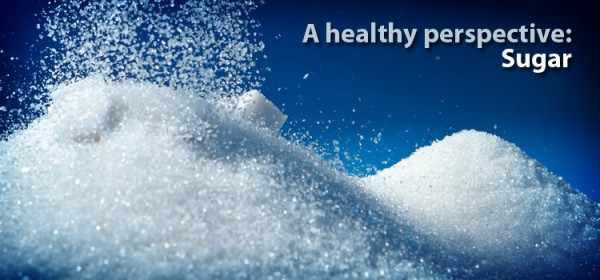A Healthy Perspective - Sugar
 My mom is a great cook, among other things. She is old school. She was the original Martha Stewart, minus all the issues. My mom coined the phrase, "If butter can't be added to it, it isn't worth cooking". Just kidding, but not really. Around the holidays my mom makes pies, cookies, fudge, and other sugary delights. A pinch of this and dash of that. She uses recipes that have been handed down from generation to generation and without question, everything she cooks is delicious. In this months healthy perspective I want to discuss sugar, how it affects the system, and steps you can take to avoid getting too much of the sweet stuff. Sorry Mom.
My mom is a great cook, among other things. She is old school. She was the original Martha Stewart, minus all the issues. My mom coined the phrase, "If butter can't be added to it, it isn't worth cooking". Just kidding, but not really. Around the holidays my mom makes pies, cookies, fudge, and other sugary delights. A pinch of this and dash of that. She uses recipes that have been handed down from generation to generation and without question, everything she cooks is delicious. In this months healthy perspective I want to discuss sugar, how it affects the system, and steps you can take to avoid getting too much of the sweet stuff. Sorry Mom.
Like millions of people I have a sweet tooth. I was raised on Kool-Aid, peanut butter and jelly, and chips. I have cavities to prove it. But even now, with everything I know about how sugar, salt and fat affects the body, I still struggle with getting too much of it. I am not talking about having a cookie or a piece of cake occasionally. It is the daily, weekly, and lifetime of indulgence of the sweet stuff. It is bags of M&Ms, quarts of ice cream, and cases of Coke. How the body uses sugar is magic, complex, and amazing. Here is a brief and over-simplified explanation of what goes on.
First off the body needs some sugar (glucose) for energy, without it we wouldn't function. The body uses insulin (a hormone created by the pancreas) to help move the sugar (glucose) from the bloodstream into the cells where it can be used. When the body does not have enough insulin, or has issues using it, sugar cannot get into the cells. The sugar builds up in the blood stream and starts causing issues that over time can lead to cellular inflammation and damage. Left unchecked, excess sugar in the system can cause obesity, heart disease, cancer, diabetes, immune issues, and more.
It is estimated that the average American consumes between 22 to 52 teaspoons of added sugars a day. The United States Department of Agriculture (USDA) recommends that the average person on a 2,000 calorie diet include no more than 40 grams or 10 teaspoons of added sugars a day1(that figures out to be the amount of sugar in a 12-ounce soft drink). So what can you and I do to tame our sweet tooth? Try the following tips:
- Eat a good solid breakfast that combines whole grains such as oatmeal and cereals. Fresh fruit, eggs, and whole grain breads are great choices as well. Eating breakfast will keep you full throughout the morning and prevent you from eating high sugary items in the vending machine or snack bar later in the morning. Eating a good quality breakfast also helps to avoid overeating at lunch.2
- Enjoy a piece of gum. Chewing gum can reduce your cravings. It also makes your breath fresh (and who doesn't need that).
- Grab an apple, banana, or some other type of fruit. The sweetness of the fruit can help curb your craving for that 2 day old donut setting on the table. Adding nuts, seeds and dried fruits can also keep you satisfied throughout the day while giving you the benefit of fiber and nutrients.
- If you can't completely go cold turkey on the sweet stuff, give in a little and enjoy a smaller equivalent. The smaller item will still allow you to enjoy what you want but without all the calories or extra sugar of the larger item.
- Plan ahead. By planning your meals and snacks you have a greater chance of success in reducing the overall amount of sugar in your diet.
- Drink water instead of fruit juice or soda pop. Most people do not get enough water throughout the day anyway. Water has numerous benefits including assisting with matabolism, regulating body temperature, detoxifying the body, and more. Fruit juices and soda pop have incredible amounts of sugar in them. For example 1 can of Coke contains 39 grams of sugar (1 gram shy of the daily recommended amount). A 20oz bottle contains 65 grams and a 2 liter bottle contains 108 grams of sugar (nearly 3 days worth).
- Limit or skip artificial sweeteners. Your results may vary but when I was drinking diet soda I still had cravings for high sugary snacks. As soon as I stopped drinking them my cravings for those foods diminished.
- Limit the amount of alcohol you drink. Excessive alcohol consumption can decrease the overall effectiveness that insulin has in moving sugar out of the blood stream. The resulting effect on the body is a high blood sugar level.
- Exercise, read a book, volunteer. I was a stress eater. M&Ms were my poison. It wasn't until I started exercising that my stress levels went down and I was able to stop the endless snacking. If you are an emotional eater get up and move around. Exercise is good for you - or so they say3. Read a good book (we have a few) to take your mind off of what might be causing you stress. Volunteering can be rewarding and has the added benefit of keeping you from that bag of chocolate you have hidden in the cupboard.
It is important that you check with your physician before making changes to your diet or exercise routines. These tips along with using common sense when you eat and drink can help ease the destructive nature sugar has on your system, and your waistline.
References
1. United States Department of Agriculture. "Profiling Food Consumption in America." 2002.
2. Health & Wellness Resource Center. "Glycemic index foods at breakfast can control blood sugar throughout the day." NewsRx Health & Science. April 22, 2012 p134.
3. Health & Wellness Resource Center. "Exercise and weight control." RelayClinical Education. February 2012.












